How to choose the right paint for radiators
One of the ways to give pipelines and radiators a beautiful look that will last for a long time is painting. In addition, you can protect them from corrosion, as well as give the visible elements the desired color so that they are combined with the interior. The painting process is simple, you only need to properly prepare all the surfaces for it. Today we will talk about how to choose the right paint and how to paint the radiator correctly.
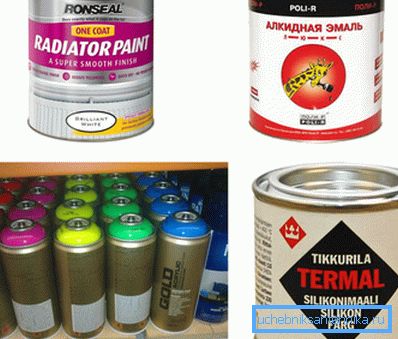
Choosing a material
This point is the most important, since it will directly depend on the final result.
Choosing, than to paint radiators of heating, we recommend to proceed from the requirements that apply to the product:
- heat resistance should not be below 100? C;
- abrasion resistance;
- no toxicity;
- resistance to aggressive environments.
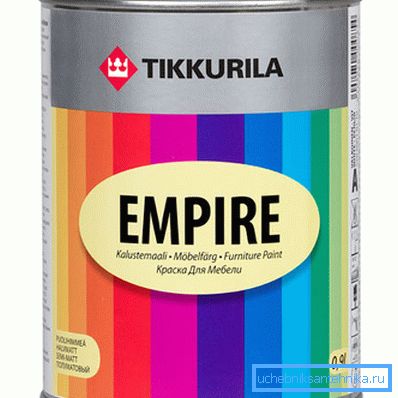
Kinds
In the construction markets and retail chains, the following types of paints and varnishes are most often offered, which are suitable for painting heating pipes:
| Enamel |
Manufacturers today offer a wide selection of colors of this material, satisfying any demand. Therefore, painting radiators and heating pipes with its help is so popular among buyers. |
| Water-dispersed | The most common material specifically designed for such purposes. During operation, the specific smell is not felt, the paint dries quickly. |
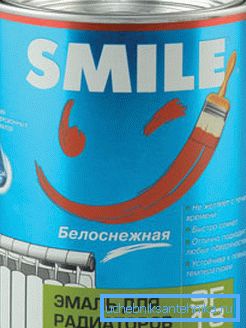
Painting radiators can be carried out with oil paints, but every year it happens less and less.
Paints manufacturers for painting pipes and radiators
Domestic and foreign companies offer in the market a sufficient number of various paints for every taste, differing in quality and color range. Their price usually depends on the brand of material and manufacturer.
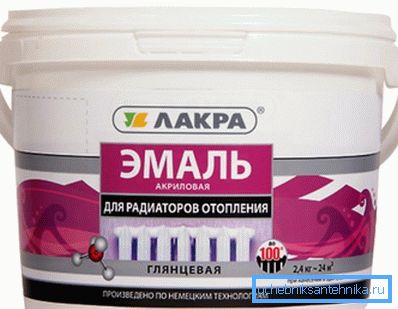
There are Dutch, Finnish, German and Swedish companies.
- Radiator Paint of the Dutch manufacturer has a white color. After staining you will get a perfect glossy surface.
- Enamel Heizkorperlack and paint Mipatherm 600 (both Germany) do not require preliminary surface preparation. After their application, the heating system can be started after only 3-4 hours, which is an advantage of the material, especially when repairs are made in winter.
- Alkyd paint from Sweden Elementfarg Alkyd is used as a 2 in 1 - primer and paint. Therefore, its use does not require separate priming. It is enough to paint the surface of the heating battery in 2 layers.
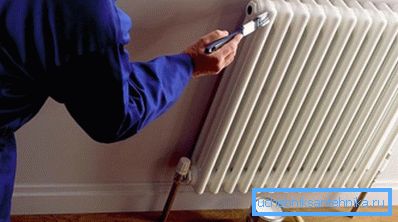
Preparation for staining
The instruction below will tell you how to prepare the pipes for painting:
- Thoroughly clean old paint and primer. Places with rust should be cleaned to a metallic sheen.
Tip: Use a brush and a damp cloth to get rid of dust and dirt, use a spatula and wash solutions for old paint.
- Apply the rinse solution to the surface of the radiator and wrap it with a film so that it softens. After some time, you can easily remove the paint with a drill with a nozzle or a spatula.
- Treat the surface with sandpaper and degrease with white spirit.
- Apply anti-corrosion primer to it, which will help protect pipes and radiators from rust, as well as improve the adhesion of paint to metal.
Tip: It is best to use an alkyd based primer.
Before you buy a primer, make sure that it has anti-corrosion protection properties, otherwise corrosion may reappear. This is usually indicated on the label.
Do not skip the preparatory stage of work, after it the paint on the surface will fall perfectly.
Now the industry produces special priming paints "2 in 1" and "3 in 1". Their composition contains a primer, rust converter and color pigments. These materials can be applied to the surface of radiators and pipes without prior preparation for painting.
Coloring
The process is quite simple, so you can do it yourself.
It should be remembered that the paint should be applied only on cold batteries and pipes.
- Before you start work, cover the floor with unnecessary newspapers, paper, cloth. Spread them right under the radiators and pipes.
- Choose a brush, preferring a small size with soft bristles curved and straight.
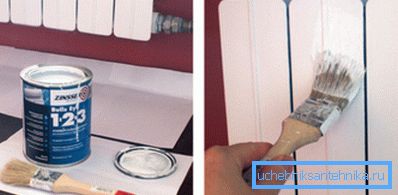
- Start applying paint from above, moving towards the bottom. Cover pipes and batteries on all sides and wait for the material to dry. Then apply a second layer to get the perfect surface.
Paints for heating radiators can be applied both from a can and with the help of an airbrush. In the latter case, the battery is desirable to remove, so you can get to remote places. If you decide to use a can, apply paint in a zigzag motion from top to bottom at a distance of about 300 mm from the surface. (See also the article Decorative screens for radiators: features.)
Conclusion
Coloring the heating pipes and batteries is a quick way to get the desired color that fits the room's interior. It also creates additional protection for the metal from corrosion and external influences. The process is simple and easy to do yourself. The video in the article will help you find additional information on this topic.